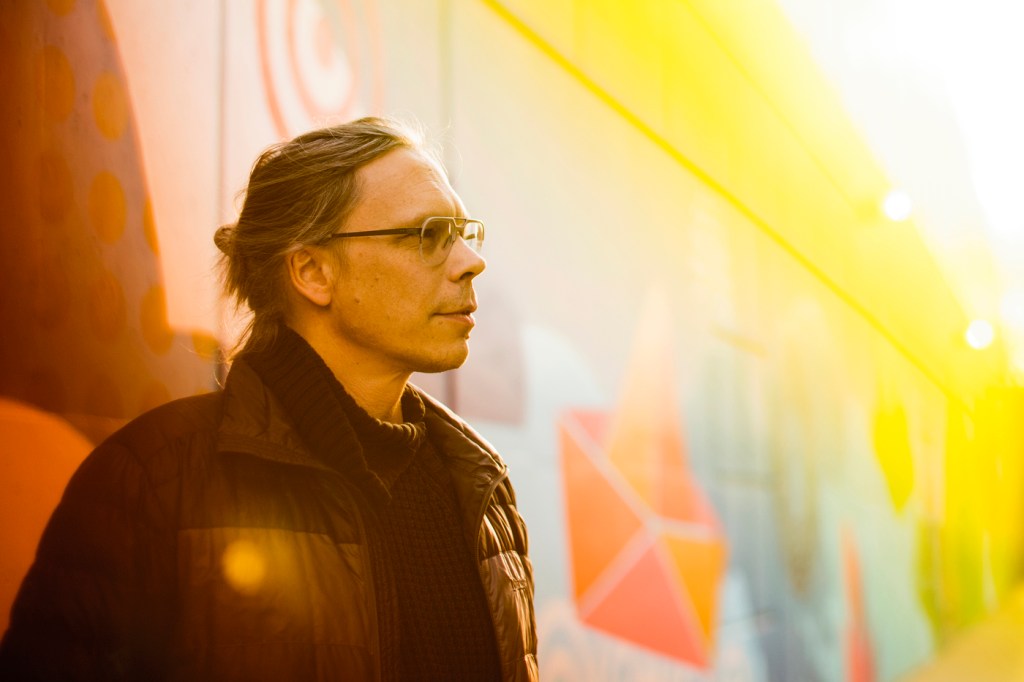He came up with a way to make data tangible and exciting

When most of us hear “data,” we think of facts and figures confined to charts and reports. For Dietmar Offenhuber, it’s not so abstract. When he sees data, his imagination takes him to a world that’s filled with all kinds of physical phenomena. Beyond percentages and statistics, he’s picturing tree rings and microplastics.
So earlier this year when the Northeastern professor was invited to design a visualization of air pollution in Stuttgart, Germany, he was right in his element. Working in tandem with a small team, he flew to the pollution-riddled city to create an installation for the Drehmoment Festival, a month-long event in October that highlights regional issues through art. His installation is called “Staubmarke,” which roughly translates to “dust marks” in English.
“For me, the main idea is to connect digital data with what you see with your sensory perception,” said Offenhuber, who teaches in the Department of Art + Design and the School of Public Policy and Urban Affairs. “Data is seen as something immaterial and abstract but this is not true. I want to bring it back to the location, back into the physical realm, into the physical context where they come from.”
The overarching goal behind his work, he said, is to improve people’s awareness of environmental issues. The idea is to show that the phenomena of pollution and climate change aren’t just concepts but physical realities.
Data is seen as something immaterial and abstract but this is not true. I want to bring it back to the location, back into the physical realm, into the physical context where they come from.
Dietmar Offenhuber, Associate Professor
Offenhuber created his installation through an existing process called “reverse graffiti.” Traditionally used by contemporary artists and activists dating back to the 1970s, reverse graffiti is a method of creating temporary images on walls or streets and sidewalks by removing dirt from a surface. Most of us have dabbled in the art form at one time or another by scrawling “Clean Me” on the rear windshield of a car, for example.
Inspired by this process, Offenhuber used a pressure washer and stencil to clean visual patterns on walls and pavements around the city. His patterns won’t last forever; the circles will fade over time, starting with the smallest ones first, as new dust accumulates in the cleared parts.
His website features four locations, with links to data collected from a local citizens group that has disagreed with the city council on how to measure air pollution. These groups serve an important function, he said, because they work hard to maintain a rigorous standard of data collection and analysis. At the same time, they face the challenge of gaining credibility or validity when their data is measured against the “official” data produced by the government. Secondly, Offenhuber said, they are making public the process by which they collect data, which lends an educational component to their work.
“Here again, the sensorial accessibility of a phenomenon is a very important element,” he said. “It’s almost like 200 years ago when people demonstrated how electricity works in public settings.”
At Northeastern, Offenhuber heads the information design and visualization graduate program. His research largely focuses on the relationship between cities, technology, and governance.
“My work mostly deals with urban data in social contexts, how different groups collect data and how that informs discourse and what role it plays in urban conflicts,” he said.
Now, Offenhuber wants to create similar visualizations for other cities around the world. He’s already working on one for Boston, which, being an older city, contends with its own unique environmental problems, he said.
“It is interesting to note that air quality in the U.S. is better than in Europe,” Offenhuber said. “The main issue [in Boston] is the industrial legacy, especially in the water.”
He’s also looking to expand his work into a forthcoming book that will examine how activists and scientists visualize data through physical traces, including synthetic biology and amateur forensics. His latest book, Waste is Information: Infrastructure Legibility and Governance, explored the relationship between infrastructure governance and the ways we read and represent waste systems.
For media inquiries, please contact media@northeastern.edu.





